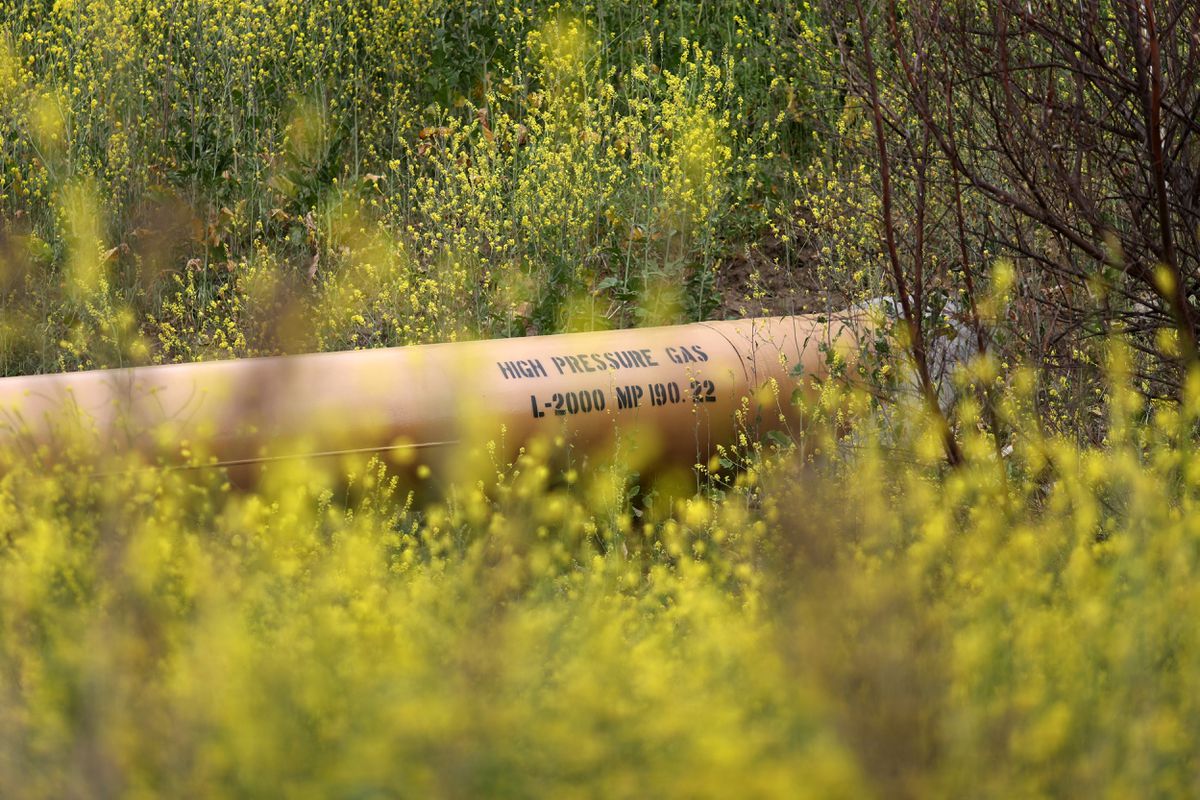 A natural gas pipeline runs through mustard plants in the burn zone of Chino Hills State Park, as the coronavirus disease (COVID-19) pandemic continues, in Chino Hills, California, U.S., April 21, 2021. REUTERS/Lucy Nicholson
A natural gas pipeline runs through mustard plants in the burn zone of Chino Hills State Park, as the coronavirus disease (COVID-19) pandemic continues, in Chino Hills, California, U.S., April 21, 2021. REUTERS/Lucy Nicholson
U.S. natural gas futures fell about 3% on Friday on record output and forecasts for mild weather and low heating demand through mid November, which should allow utilities to inject more gas into storage than usual for at least a few more weeks.
That price decline came despite the return to service from maintenance of Berkshire Hathaway Energy's 0.8 billion cubic feet per day (bcfd) Cove Point liquefied natural gas (LNG) export plant in Maryland, which will boost U.S. demand for gas for exports.
The market was still waiting for the return of Freeport LNG's export plant in Texas. Freeport has said it expects the facility to return to at least partial service in early- to mid-November following an unexpected shutdown on June 8 due to a pipeline explosion.
At least three vessels were heading to Freeport, according to Refinitiv data. Prism Brilliance and Prism Diversity were both waiting off the coast from the plant, while Prism Courage was expected to arrive on Nov. 1.
On its first day as the front-month, gas futures for December delivery fell 19.1 cents, or 3.3%, to settle at $5.684 per million British thermal units (mmBtu).
That put the front-month up about 10% for the day since the December contract was trading much higher than where the now expired November future settled. That would be the highest close since Oct. 18 and the biggest daily percentage gain since mid September.
For the week, the contract was on track to gain about 15% after plunging about 23% last week. That would be its first weekly gain in 10 weeks.
U.S. gas futures are up about 53% so far this year as soaring global gas prices feed demand for U.S. exports due to supply disruptions and sanctions linked to Russia.
Gas was trading at $32 per mmBtu at the Dutch Title Transfer Facility (TTF) in Europe and $30 at the Japan Korea Marker (JKM) in Asia .
TOP PRODUCER
U.S. gas futures lag far behind global prices because the United States is the world's top producer with all the fuel it needs for domestic use, while capacity constraints and the Freeport outage prevent the country from exporting more LNG.
Data provider Refinitiv said average gas output in the U.S. Lower 48 states rose to 99.5 bcfd so far in October, up from a monthly record of 99.4 in September.
With the coming of seasonally cooler weather, Refinitiv projected average U.S. gas demand, including exports, would rise from 94.3 bcfd this week to 97.0 bcfd next week and 101.6 bcfd in two weeks. The forecast for next week was higher than Refinitiv's outlook on Thursday due to an expected rise in LNG exports with the return of Cove Point.
The average amount of gas flowing to U.S. LNG export plants fell to 11.2 bcfd so far in October due to the Cove Point outage, down from 11.5 bcfd in September and well below the monthly record of 12.9 bcfd in March. The seven big U.S. export plants can turn about 13.8 bcfd of gas into LNG.
During the first nine months of 2022, roughly 60%, or 6.3 bcfd, of U.S. LNG exports went to Europe, as shippers diverted cargoes from Asia to fetch higher prices. Last year, just 29%, or about 2.8 bcfd, of U.S. LNG exports went to Europe.
